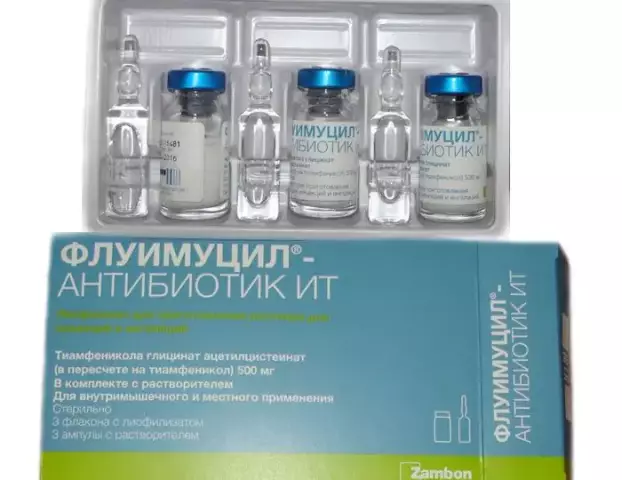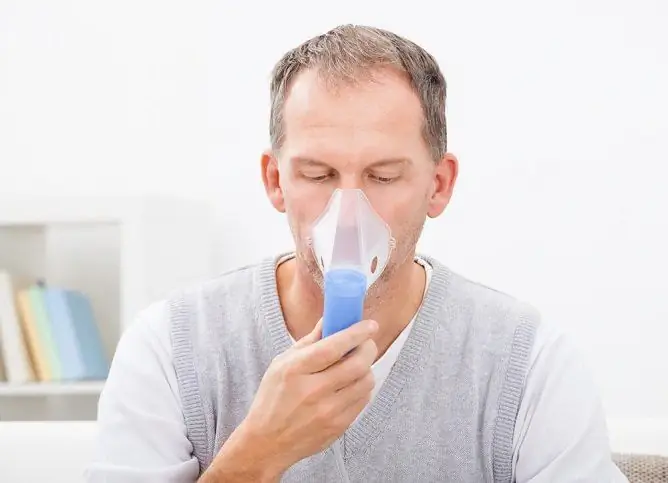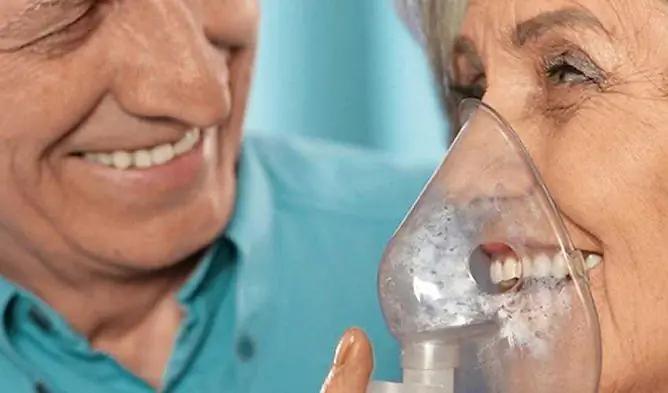- Author Rachel Wainwright [email protected].
- Public 2023-12-15 07:39.
- Last modified 2025-11-02 20:14.
Ipraterol-native
Ipraterol-native: instructions for use and reviews
- 1. Release form and composition
- 2. Pharmacological properties
- 3. Indications for use
- 4. Contraindications
- 5. Method of application and dosage
- 6. Side effects
- 7. Overdose
- 8. Special instructions
- 9. Application during pregnancy and lactation
- 10. Use in childhood
- 11. Drug interactions
- 12. Analogs
- 13. Terms and conditions of storage
- 14. Terms of dispensing from pharmacies
- 15. Reviews
- 16. Price in pharmacies
Latin name: Ipraterol-nativ
ATX code: R03AL01
Active ingredient: fenoterol (Fenoterol), ipratropium bromide (Ipratropium Bromide)
Manufacturer: JSC Pharmstandard-Leksredstva (Russia); Nativa, OOO (Russia)
Description and photo update: 2019-08-07
Prices in pharmacies: from 209 rubles.
Buy

Ipraterol-native is a combined bronchodilator drug.
Release form and composition
The drug is available in the form of a solution for inhalation: a clear liquid, colorless or having a weak yellow tint (20 ml each in dark glass vials with a built-in polyethylene dropper, 1 vial in a cardboard box and instructions for use of Ipraterol-native).
1 ml of solution contains:
- active ingredients: ipratropium bromide monohydrate - 0.261 mg (equivalent to 0.25 mg of ipratropium bromide); fenoterol hydrobromide - 0.5 mg;
- auxiliary components: citric acid monohydrate, sodium edetate, sodium benzoate, sodium hydroxide (acidity 3.2), water for injection.
Pharmacological properties
Pharmacodynamics
Ipraterol-native is a bronchodilating drug containing two components with bronchodilator activity: an m-anticholinergic blocker - ipratropium bromide and a selective beta 2 -adrenomimetic - fenoterol.
The bronchodilating effect of the inhalation solution Ipraterol-native is achieved as a result of the action of an m-anticholinergic blocker and beta 2 -adrenomimetic on various pharmacological targets. Complementing the effect of each other, the active substances enhance the antispasmodic effect on the muscles of the bronchi. The combined composition provides a wide range of therapeutic action of the drug for bronchopulmonary pathologies accompanied by airway constriction, allowing the desired effect to be achieved when using a lower dose of the beta-adrenergic component. The combination of ipratropium bromide and fenoterol allows you to select an individual effective dose, significantly reducing the risk of side effects.
Due to the fact that the action of the drug in the treatment of acute bronchoconstriction develops rapidly, it is effectively used to treat acute attacks of bronchospasm.
Ipratropium bromide
Ipratropium bromide is a quaternary ammonium derivative with a pronounced anticholinergic (parasympatholytic) effect. The substance has a depressing effect on reflexes caused by the vagus nerve, thereby counteracting the acetylcholine mediator released from the ends of the vagus nerve. Anticholinergics prevent an increase in the intracellular level of calcium ions, which occurs as a result of the interaction of acetylcholine and muscarinic receptors of smooth muscles of the bronchi. The release of calcium ions is indirectly involved in the system of secondary mediators, including ITP (inositol triphosphate) and DAG (diacylglycerol).
When administered by inhalation, bronchodilation is largely due not to the systemic, but to the local anticholinergic action of ipratropium bromide.
After inhalation a significant improvement in lung function in patients with bronchospasm associated with chronic obstructive lung diseases (including chronic bronchitis, pulmonary emphysema) occurs within 1 / 4 hour. There is an increase of 15% or more in the forced expiratory volume in 1 second and in the peak expiratory flow rate. The maximum effect is achieved within 1-2 hours and in most patients it lasts for 6 hours.
Ipratropium bromide does not adversely affect mucociliary clearance, gas exchange and mucus secretion in the respiratory tract.
Fenoterol hydrobromide
Fenoterol - 1- (3,5-Dioxyphenyl) -2- (para-hydroxy-a-methyl-phenethylamino) -ethanol, beta 2 -adrenoreceptor adrenoagonist. In therapeutic doses, fenoterol stimulates beta 2 -adrenergic receptors selectively, and its stimulating effect on beta 1 -adrenergic receptors is manifested only when high doses are used.
The relaxing effect of fenoterol on the smooth muscles of the bronchi and blood vessels helps prevent the development of bronchospastic reactions that occur under the influence of methacholine, histamine, allergens and cold air. Its blocking effect on the release of mediators of inflammation and bronchial obstruction from mast cells occurs immediately after application. With the use of higher doses of fenoterol, an increase in mucociliary clearance is noted.
The vascular action of fenoterol, which stimulates the beta 2 -adrenergic receptors of the heart, causes the beta-adrenergic effect of the drug on cardiac activity, causing an increase in the frequency and strength of heart contractions. Like other beta-adrenergic drugs, high doses of fenoterol can prolong the QTc interval. The clinical significance of this manifestation has not been established.
The most common side effect of beta-adrenergic agonists is tremor.
Pharmacokinetics
Ipratropium bromide, when administered by inhalation, is extremely weakly absorbed from the mucous membrane of the respiratory tract. Its concentration in plasma can only be determined by using special enrichment methods or using high doses. The total systemic bioavailability of the substance after inhalation is from 7 to 28%. Due to the use of ipratropium bromide in therapeutic doses, its plasma concentration is 1000 times lower than this indicator after intravenous administration or oral administration.
When fenoterol is administered by inhalation, 10-30% reaches the lower respiratory tract (depending on the inhalation method and the inhalation system used), the rest is swallowed and enters the gastrointestinal tract. There is no correlation between the levels of fenoterol that are achieved after inhalation in the blood plasma and the pharmacodynamic curve "time-effect". The duration of the bronchodilatory action is not supported in the systemic circulation by high concentrations of the active substance. After the introduction of fenoterol inside, about 60% of the dose is absorbed; it takes 2 hours to reach its maximum concentration (C max) in blood plasma.
Being a derivative of quaternary nitrogen, ipratropium bromide is poorly soluble in fatty media and is not capable of significant penetration through biological membranes, does not cumulate.
Plasma protein binding of fenoterol is 40-55%. Fenoterol crosses the placental barrier unchanged, excreted in breast milk.
Ipratropium bromide is metabolized in the liver to form eight known metabolites of ipratropium. Their connection with muscarinic receptors is negligible.
Fenoterol is metabolized in the liver. Its biotransformation takes place in the intestinal wall exclusively by conjugation with sulfates. The swallowed amount of the drug after inhalation has practically no effect on the level of the active substance in the blood plasma.
The excretion of ipratropium bromide occurs mainly through the intestines: unchanged - about 25%, in the form of metabolites - the rest.
Fenoterol is excreted through the kidneys and intestines in the form of inactive sulfate conjugates.
Pharmacokinetic parameters of a drug containing a combination of ipratropium bromide and fenoterol in elderly and children, patients with impaired liver and / or kidney function, patients with diabetes mellitus have not been studied.
Indications for use
The use of the solution for inhalation Ipraterol-native is indicated for the prevention and symptomatic treatment of chronic obstructive airway diseases with their reversible obstruction, including chronic obstructive pulmonary disease, bronchial asthma, chronic obstructive bronchitis without or with emphysema.
Contraindications
Absolute:
- tachyarrhythmia;
- hypertrophic obstructive cardiomyopathy;
- I trimester of pregnancy;
- hypersensitivity to the active ingredients of ipraterol-native, other atropine-like substances and auxiliary ingredients.
With caution, the solution for inhalation Ipraterol-native should be prescribed to patients with diabetes mellitus, angle-closure glaucoma, arterial hypertension, chronic heart failure, aortic stenosis, ischemic heart disease, severe lesions of the cerebral and peripheral arteries, after a recent (within the last three months) suffered a heart attack myocardium, with hyperthyroidism, pheochromocytoma, bladder neck obstruction, prostatic hyperplasia, cystic fibrosis, in the II - III trimesters of pregnancy, during lactation and children under the age of 6 years.
Ipraterol-native, instructions for use: method and dosage
Ipraterol-native is intended for use by inhalation using appropriate nebulizers.
Treatment is required under medical supervision (for example, in a hospital setting). At home, therapy is possible only after consulting a doctor and only in cases where low doses of a fast-acting beta-agonist are not effective enough. In addition, the inhalation solution can be recommended for use by patients who, for a number of reasons, cannot use an aerosol for inhalation or, if necessary, prescribe higher doses.
Immediately before inhalation, the prescribed dose of the drug is diluted in 0.9% sodium chloride solution to obtain a total volume of 3-4 ml. The prepared solution should be used immediately. Ipraterol-native should not be used orally or diluted with distilled water.
Various commercial nebulizer models are suitable for inhalation. In the presence of wall oxygen, it is recommended to use Ipraterol-native at a flow rate of 6-8 l / min. The duration of inhalation can be controlled by the consumption of the finished solution.
The doctor selects the dose individually, taking into account the inhalation method and the type of nebulizer. Treatment should be started with the lowest therapeutic dose.
Recommended dosage of Ipraterol-native for adolescents over the age of 12 years and adult patients, including older and elderly people:
- acute attacks of bronchial asthma: mild and moderate attack - 20 drops (1 ml) per 1 inhalation; severe seizure (including patients in intensive care units) - up to 50 drops (2.5 ml) per 1 inhalation, with ineffective doses for moderate seizures. The maximum single dose is 80 drops (4 ml), the daily dose is 160 drops (8 ml);
- course and long-term treatment: 20-40 drops (1-2 ml) per 1 inhalation, no more than 4 procedures per day;
- moderate bronchospasm, ventilation of the lungs (as an aid): the lower dose level should be 10 drops (0.5 ml) per 1 inhalation.
Recommended dosage of Ipraterol-native for children aged 6-12 years:
- acute attacks of bronchial asthma: 10-20 drops (0.5-1 ml) per 1 inhalation; in severe cases, when symptoms cannot be quickly relieved, a single dose can be increased to 40 drops (2 ml) per 1 inhalation. For especially severe cases (with 40 drops ineffective), it is possible to use a maximum dose of 60 drops (3 ml) per 1 inhalation only under medical supervision. The maximum daily dose is 80 drops (4 ml);
- course and long-term treatment: 10-20 drops per 1 inhalation, no more than 4 procedures per day;
- moderate degree of bronchospasm, ventilation of the lungs (as an aid): 10 drops per 1 inhalation.
The use of Ipraterol-native in children under 6 years of age (body weight less than 22 kg) should be carried out only under close medical supervision. The size of one dose is determined at the rate of 2 drops (0.1 ml) per 1 kg of the child's weight, but not more than 10 drops per 1 inhalation. The maximum daily dose is 30 drops (1.5 ml).
It is necessary to follow the instructions for use of the nebulizer, including careful regular care of it.
Side effects
- on the part of the central and peripheral nervous system: often - nervousness, minor tremor of skeletal muscles; rarely - headache, dizziness; very rarely - a change in the psyche;
- on the part of the heart and blood vessels: often - tachycardia (including supraventricular tachycardia), palpitations (more often with aggravating factors); rarely (with the use of high doses) - arrhythmia (including atrial fibrillation), a decrease in diastolic blood pressure (DBP), an increase in systolic blood pressure (SBP);
- from the respiratory system: rarely - pharyngitis, local irritation of the respiratory tract, cough; very rarely - laryngospasm, paradoxical bronchospasm;
- from the gastrointestinal tract: often - dry mouth; infrequently - vomiting, constipation, impaired motility of the gastrointestinal tract, diarrhea (more often with cystic fibrosis);
- on the part of the organ of vision: if the solution gets into the eyes - pain in the eyeball, increased intraocular pressure, mydriasis, glaucoma; very rarely - reversible accommodation disturbances, glaucoma, the symptoms of which are conjunctival hyperemia, corneal (stromal) edema, discomfort or pain in the eyeball, blurred vision, the appearance of colored spots or a halo in front of the eyes;
- from the immune system: rarely - skin rash, urticaria, angioedema of the tongue, lips and / or face;
- other reactions: general weakness, hyperhidrosis (increased sweating), urinary retention, hypokalemia, myalgia.
Overdose
- symptoms: the most likely symptoms, usually associated with the action of fenoterol and caused by excessive stimulation of β-adrenergic receptors, include the appearance of tremor, an increase in blood pressure, an increase in the gap between systolic and diastolic blood pressure, tachycardia, palpitations, angina pectoris, arrhythmias, flushing of the face, feeling of heaviness behind the breastbone, increased metabolic acidosis, bronchial obstruction. Due to an overdose of ipratropium bromide, there may be a slight disturbance in the accommodation of the eyes, dry mouth, taking into account the breadth of the therapeutic effect and the local method of application of the substance, they are usually weakly expressed and are transient;
- treatment: the use of the inhalation solution Ipraterol-native must be discontinued, after which, taking into account the data of monitoring the acid-base balance of the blood, sedatives, tranquilizers (anxiolytics) are prescribed. Intensive therapy may be required to treat severe overdose. As a specific antidote, the use of selective beta 1 -adrenergic blockers is allowed. In this case, the dose of the beta-blocker should be carefully selected, taking into account the possible intensification of bronchial obstruction in patients with chronic obstructive pulmonary disease or bronchial asthma, which can lead to the development of severe bronchospasm, up to death.
special instructions
In cases where sudden difficulty in breathing (shortness of breath) progresses rapidly, you should immediately consult a doctor.
With long-term therapy of Ipraterol-native in patients with bronchial asthma or mild and moderate chronic obstructive pulmonary disease, symptomatic use of the drug is considered preferable.
In severe forms of chronic obstructive pulmonary disease and bronchial asthma, the simultaneous implementation of appropriate anti-inflammatory therapy is required to control the inflammatory processes in the airways and the course of the disease.
If the use of regularly increasing doses is required to relieve bronchial obstruction, this can cause an uncontrolled worsening of the course of the disease, due to the content of beta 2 -adrenomimetic in Ipraterol-native. It is important to bear in mind that the frequent increase in the dose of beta 2 -agonists to relieve increasing bronchial obstruction is unjustified and dangerous. Therefore, you should change the treatment plan, supplementing it with such inhaled glucocorticosteroids, which will prevent inflammation and life-threatening worsening of the disease.
With cystic fibrosis, a violation of the motility of the gastrointestinal tract is possible.
It must be remembered that with hypoxia, the negative effect of hypokalemia on the heart rate may increase.
Other sympathomimetic bronchodilators can be used simultaneously with the Ipraterol-native inhalation solution only under medical supervision.
When prescribing Ipraterol-native, the patient should be instructed in detail about the rules for its use. Do not allow the solution to get into the eyes, especially if you have a predisposition to the development of glaucoma. It is recommended to use a mouthpiece or mask tightly to the face when using the inhalation nebulizer.
Influence on the ability to drive vehicles and complex mechanisms
Due to the likelihood of dizziness and blurred vision while using Ipraterol-native, patients should be careful when driving vehicles and working with complex mechanisms.
Application during pregnancy and lactation
Pregnant women are contraindicated to use Ipraterol-native in the first trimester of gestation.
A combined bronchodilator should be prescribed with caution in the II-III trimesters of pregnancy, due to the possible weakening of labor, and during lactation.
It should be borne in mind that fenoterol can have an inhibitory effect on the contractile activity of the uterus and passes into breast milk.
Pediatric use
Ipraterol-native should be used with caution in children under 6 years of age.
Drug interactions
With simultaneous use with Ipraterol-native:
- other anticholinergic drugs: their long-term simultaneous use with Ipraterol-native is not recommended due to lack of data;
- cromoglicic acid, glucocorticosteroids: their additional purpose helps to increase the effectiveness of therapy;
- beta-adrenomimetics, anticholinergics of systemic action, theophylline and other xanthine derivatives: concomitant therapy with these drugs can enhance the bronchodilatory effect of the solution and lead to an exacerbation of unwanted reactions;
- beta-blockers: can contribute to a significant weakening of the bronchodilatory effect of ipraterol-native;
- diuretics, xanthine derivatives, glucocorticosteroids: consideration should be given to the possible increase in the existing hypokalemia with this combination, especially in patients with severe obstructive respiratory diseases; with this combination, monitoring of serum potassium concentration is recommended;
- Digoxin: In patients with hypokalemia, digoxin may increase the risk of arrhythmias. If you need to take digoxin, you need to regularly monitor the level of potassium in the blood serum;
- monoamine oxidase (MAO) inhibitors, tricyclic antidepressants: care should be taken when using them in combination with Ipraterol-native due to the increase in its beta-adrenergic action;
- halothane, trichlorethylene, enflurane: general anesthesia with inhalation of halogenated hydrocarbon anesthetics may increase the effect of the drug on the cardiovascular system.
Analogs
Ipraterol-native analogs are Ipraterol-aeronaut, Berodual N, Berodual, Inspirax, Fenipra, Astmasol-SOLOfarm, etc.
Terms and conditions of storage
Keep out of the reach of children.
Store at temperatures up to 25 ° C in a dark place, protect from freezing.
Shelf life is 2 years.
Terms of dispensing from pharmacies
Dispensed by prescription.
Reviews of Ipraterol-native
Reviews of Ipraterol-native are quite contradictory. Most patients indicate the effectiveness of the drug in the treatment of bronchial asthma, chronic bronchitis, pneumonia, relief of shortness of breath symptoms. They note that the drug quickly relieves breathing during attacks of suffocation without causing side effects at the same time.
At the same time, quite often there are negative reviews of patients for whom Ipraterol-native did not help.
Price for Ipraterol-native in pharmacies
The price of Ipraterol-native for a package containing 1 bottle (20 ml of solution) can range from 182 rubles.
Ipraterol-native: prices in online pharmacies
|
Drug name Price Pharmacy |
|
Ipraterol-native 0.25 mg + 0.5 mg / ml solution for inhalation 20 ml 1 pc. 209 RUB Buy |
|
Ipraterol-Nativ solution for ing 0.25mg / ml + 0.5mg / ml 20ml 245 RUB Buy |

Anna Kozlova Medical journalist About the author
Education: Rostov State Medical University, specialty "General Medicine".
Information about the drug is generalized, provided for informational purposes only and does not replace the official instructions. Self-medication is hazardous to health!






